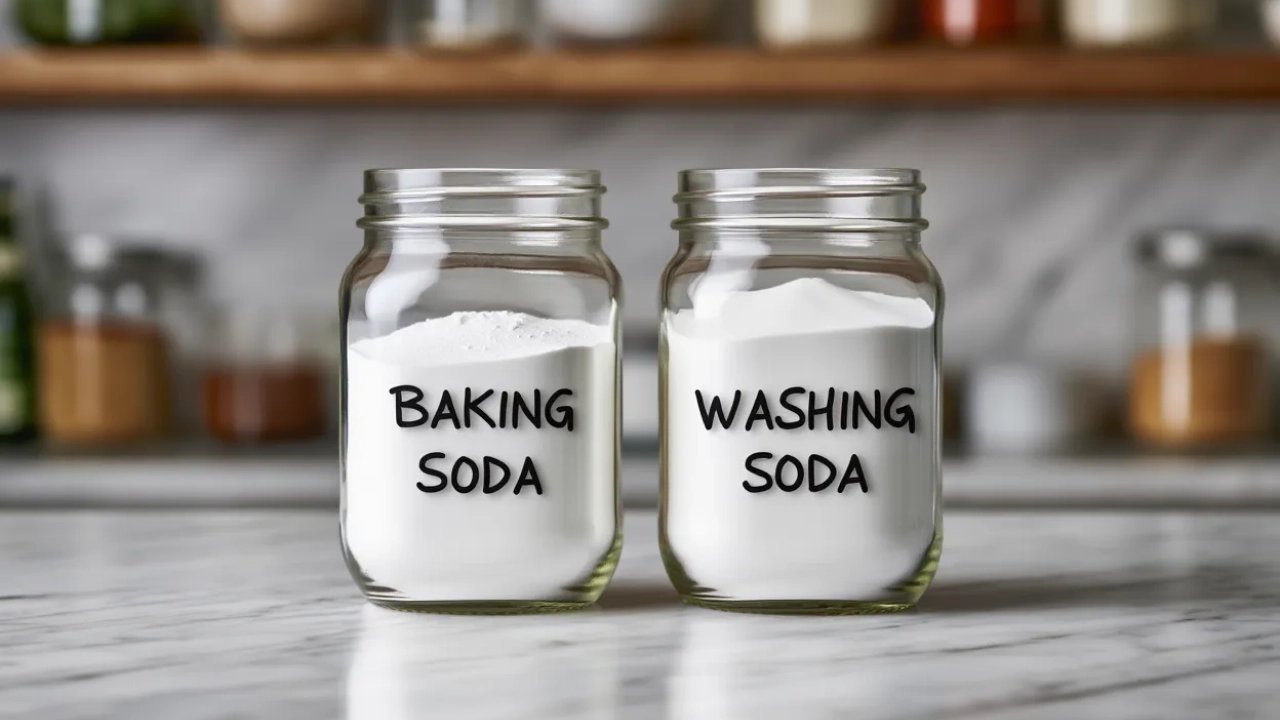Difference Between Baking Soda and Washing Soda: A Complete Guide

Introduction
In the world of household cleaning and DIY remedies, two pantry staples often spark confusion: baking soda and washing soda. While they sound similar and share some uses, they are chemically distinct compounds with different strengths and applications. Understanding the difference between sodium bicarbonate and sodium carbonate can help you choose the right one for your needs, whether you’re tackling tough stains, baking a cake, or adjusting pool pH.
This guide breaks down their chemical makeup, key differences, common uses, and safety tips. If you’re wondering “baking soda vs washing soda—which is better for laundry?” or how they relate to sodium bicarbonate vs sodium carbonate, read on for expert insights.
What Is Baking Soda? (Sodium Bicarbonate)
Baking soda, scientifically known as sodium bicarbonate (NaHCO₃), is a mild alkaline powder that’s a kitchen essential. It’s naturally occurring or produced via the Solvay process, where carbon dioxide reacts with salt and ammonia.
- Appearance: Fine, white powder.
- pH Level: Around 8.3 (mildly alkaline).
- Key Properties: Releases carbon dioxide when mixed with acids (like vinegar or lemon juice), creating fizz for leavening in baking or cleaning.
Baking soda is versatile, food-grade, and gentle enough for skin contact, making it a go-to for odor neutralization and light scrubbing.
What Is Washing Soda? (Sodium Carbonate or Soda Ash)
Washing soda, or sodium carbonate (Na₂CO₃), is a stronger alkaline compound often derived from mining trona ore or synthesized industrially. It’s essentially dehydrated baking soda—heating sodium bicarbonate at 200°C converts it to washing soda, releasing water and CO₂.
- Appearance: White, crystalline powder (often in decahydrate form as soda crystals).
- pH Level: 11–12 (highly alkaline).
- Key Properties: Excellent water softener; breaks down grease and minerals aggressively.
Unlike baking soda, washing soda isn’t edible and requires caution around skin and eyes due to its caustic nature.
Key Differences: Baking Soda vs Washing Soda
The core difference between sodium bicarbonate and sodium carbonate lies in their molecular structure—one has an extra hydrogen atom, affecting reactivity, solubility, and strength. Here’s a quick comparison:
| Aspect | Baking Soda (NaHCO₃) | Washing Soda (Na₂CO₃) |
|---|---|---|
| Chemical Formula | NaHCO₃ (sodium bicarbonate) | Na₂CO₃ (sodium carbonate) |
| pH Level | 8.3 (mild) | 11–12 (strong) |
| Alkalinity | Gentle; safe for food and skin | Harsh; can irritate skin/eyes |
| Solubility in Water | Highly soluble; forms bicarbonate ions | Very soluble; softens hard water |
| Reaction with Acid | Fizzes vigorously (CO₂ release) | Slower fizz; more focused on grease |
| Cost | $0.50–$1 per lb (widely available) | $1–$2 per lb (less common) |
| Edibility | Yes (food-grade) | No (industrial cleaner) |
In short, baking soda is your mild multitasker, while washing soda is the heavy-duty cleaner. For example, in laundry, washing soda cuts through mineral buildup better, but baking soda freshens without stripping fabrics.
Common Uses and Applications
Both compounds shine in eco-friendly cleaning, but their strengths dictate the best scenarios.
Baking Soda Uses
- Baking: Acts as a leavening agent in cookies, cakes, and muffins.
- Cleaning: Deodorizes refrigerators, scrubs grout, or polishes silver (mix with water for a paste).
- Personal Care: Relieves heartburn (as an antacid), soothes bug bites, or exfoliates skin in DIY scrubs.
- Other: Neutralizes odors in carpets or shoes; extinguishes small grease fires.
Pro Tip: For a natural drain cleaner, sprinkle baking soda followed by vinegar—the reaction unclogs without harsh chemicals.
Washing Soda Uses
- Laundry: Boosts detergent by softening water; ideal for stain removal on whites and heavy fabrics.
- Household Cleaning: Dissolves grease on stovetops, unblocks drains, or cleans ovens (dissolve in hot water).
- DIY Projects: Makes homemade soap or scouring powder; adjusts pH in swimming pools.
- Industrial: Used in glass manufacturing, paper production, and water treatment.
If you’re asking “washing soda vs baking soda for laundry,” opt for washing soda on tough loads—it’s 3x more alkaline, enhancing soap efficiency.
Safety and Handling Tips
- Baking Soda: Generally safe; rinse skin if irritated. Store in a cool, dry place to prevent clumping.
- Washing Soda: Wear gloves—prolonged exposure can cause dryness or burns. Keep away from children and pets; rinse thoroughly after use.
- Storage: Both absorb moisture, so use airtight containers. Avoid mixing with acids unless intentional (e.g., for fizz).
In emergencies, rinse affected areas with water and seek medical advice for ingestion.
Can You Substitute One for the Other?
Not always. You can make washing soda from baking soda by baking it at 400°F for 1 hour (dehydrates it), but the reverse isn’t possible without lab equipment. For most cleaning, baking soda suffices as a gentler alternative.
Conclusion: Choose Based on Your Needs
The difference between baking soda and washing soda boils down to power vs. versatility—baking soda for everyday gentle tasks, washing soda for deep cleans. Both are affordable, non-toxic alternatives to chemical-heavy products, promoting sustainable living.

